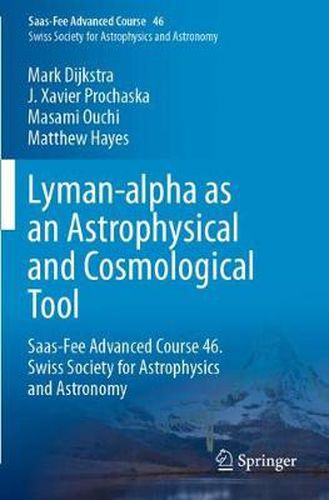Readings Newsletter
Become a Readings Member to make your shopping experience even easier.
Sign in or sign up for free!
You’re not far away from qualifying for FREE standard shipping within Australia
You’ve qualified for FREE standard shipping within Australia
The cart is loading…






This title is printed to order. This book may have been self-published. If so, we cannot guarantee the quality of the content. In the main most books will have gone through the editing process however some may not. We therefore suggest that you be aware of this before ordering this book. If in doubt check either the author or publisher’s details as we are unable to accept any returns unless they are faulty. Please contact us if you have any questions.
The hydrogen Lyman-alpha line is of utmost importance to many fields of astrophysics. This UV line being conveniently redshifted with distance to the visible and even near infrared wavelength ranges, it is observable from the ground, and provides the main observational window on the formation and evolution of high redshift galaxies. Absorbing systems that would otherwise go unnoticed are revealed through the Lyman-alpha forest, Lyman-limit, and damped Lyman-alpha systems, tracing the distribution of baryonic matter on large scales, and its chemical enrichment.
We are living an exciting epoch with the advent of new instruments and facilities, on board of satellites and on the ground. Wide field and very sensitive integral field spectrographs are becoming available on the ground, such as MUSE at the ESO VLT. The giant E-ELT and TMT telescopes will foster a quantum leap in sensitivity and both spatial and spectroscopic resolution, to the point of being able, perhaps, to measure directly the acceleration of the Hubble flow. In space, the JWST will open new possibilities to study the Lyman-alpha emission of primordial galaxies in the near infrared. As long as the Hubble Space Telescope will remain available, the UV-restframe properties of nearby galaxies will be accessible to our knowledge. Therefore, this Saas-Fee course appears very timely and should meet the interest of many young researchers.
$9.00 standard shipping within Australia
FREE standard shipping within Australia for orders over $100.00
Express & International shipping calculated at checkout
This title is printed to order. This book may have been self-published. If so, we cannot guarantee the quality of the content. In the main most books will have gone through the editing process however some may not. We therefore suggest that you be aware of this before ordering this book. If in doubt check either the author or publisher’s details as we are unable to accept any returns unless they are faulty. Please contact us if you have any questions.
The hydrogen Lyman-alpha line is of utmost importance to many fields of astrophysics. This UV line being conveniently redshifted with distance to the visible and even near infrared wavelength ranges, it is observable from the ground, and provides the main observational window on the formation and evolution of high redshift galaxies. Absorbing systems that would otherwise go unnoticed are revealed through the Lyman-alpha forest, Lyman-limit, and damped Lyman-alpha systems, tracing the distribution of baryonic matter on large scales, and its chemical enrichment.
We are living an exciting epoch with the advent of new instruments and facilities, on board of satellites and on the ground. Wide field and very sensitive integral field spectrographs are becoming available on the ground, such as MUSE at the ESO VLT. The giant E-ELT and TMT telescopes will foster a quantum leap in sensitivity and both spatial and spectroscopic resolution, to the point of being able, perhaps, to measure directly the acceleration of the Hubble flow. In space, the JWST will open new possibilities to study the Lyman-alpha emission of primordial galaxies in the near infrared. As long as the Hubble Space Telescope will remain available, the UV-restframe properties of nearby galaxies will be accessible to our knowledge. Therefore, this Saas-Fee course appears very timely and should meet the interest of many young researchers.